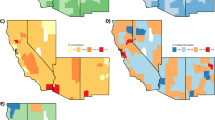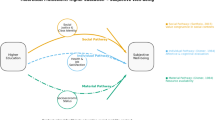Abstract
With growing levels of inequality, understanding relationships between socioeconomic status (SES), health and well-being is as important as ever. Many studies focus on associations between an SES composite and either health ‘or’ happiness; here we examine unique relationships between SES indicators (income and education) and health ‘and’ well-being outcomes at both individual and community levels, drawing on a sample of adults (N = 71,385; Mage = 40.62, s.d. = 13.20) from more than 10 countries and representing 13,089 unique ZIP codes within the United States. A subset (N = 29,567) participated in an Ecological Momentary Assessment study by providing daily reports of their emotions, blood pressure and heart rate (Nobs = 329,543) for 3 weeks. Generally, higher levels of education were more consistently linked to indicators of better health, whereas higher levels of income were associated with higher levels of well-being. Individual-level SES predicted health and well-being more strongly than community-level factors.
This is a preview of subscription content, access via your institution
Access options
Access Nature and 54 other Nature Portfolio journals
Get Nature+, our best-value online-access subscription
$32.99 / 30 days
cancel any time
Subscribe to this journal
Receive 12 digital issues and online access to articles
$119.00 per year
only $9.92 per issue
Buy this article
- Purchase on SpringerLink
- Instant access to full article PDF
Prices may be subject to local taxes which are calculated during checkout



Similar content being viewed by others
Data availability
Data are available in OSF at https://osf.io/25wk3/ (ref. 43).
Code availability
Analytic code files are available in OSF at https://osf.io/25wk3/ (ref. 43).
References
Adler, N. E. et al. Socioeconomic status and health: the challenge of the gradient. Am. Psychol. 49, 15–24 (1994).
Borghesi, S. & Vercelli, A. Happiness and health: two paradoxes. J. Econ. Surv. 26, 203–233 (2012).
Killingsworth, M. A. Experienced well-being rises with income, even above $75,000 per year. Proc. Natl Acad. Sci. USA 118, e2016976118 (2021).
Adler, N. E. & Ostrove, J. M. Socioeconomic status and health: what we know and what we don’t. Ann. N. Y. Acad. Sci. 896, 3–15 (1999).
Johnson-Lawrence, V., Zajacova, A. & Sneed, R. Education, race/ethnicity, and multimorbidity among adults aged 30–64 in the National Health Interview Survey. SSM Popul. Health 3, 366–372 (2017).
Udalova, V., Bhatia, V. & Polyakova, M. Association of family income with morbidity and mortality among US lower-income children and adolescents. JAMA 328, 2422–2430 (2022).
Kraus, M. W., Piff, P. K. & Keltner, D. Social class, sense of control, and social explanation. J. Pers. Soc. Psychol. 97, 992–1004 (2009).
Tan, J. J. X., Kraus, M. W., Carpenter, N. C. & Adler, N. E. The association between objective and subjective socioeconomic status and subjective well-being: a meta-analytic review. Psychol. Bull. 146, 970–1020 (2020).
Easterlin, R. A. in Nations and Households in Economic Growth (eds David, P. A. & Reder, M. W.) 89–125 (Academic Press, 1974).
Stevenson, B. & Wolfers, J. Economic Growth and Subjective Well-being: Reassessing the Easterlin Paradox Working Paper 14282 (NBER, 2008).
Kahneman, D. & Deaton, A. High income improves evaluation of life but not emotional well-being. Proc. Natl Acad. Sci. USA 107, 16489–16493 (2010).
Killingsworth, M. A., Kahneman, D. & Mellers, B. Income and emotional well-being: a conflict resolved. Proc. Natl Acad. Sci. USA 120, e2208661120 (2023).
Jebb, A. T., Tay, L., Diener, E. & Oishi, S. Happiness, income satiation and turning points around the world. Nat. Hum. Behav. 2, 33–38 (2018).
Dunn, E. W., Aknin, L. B. & Norton, M. I. Spending money on others promotes happiness. Science 319, 1687–1688 (2008).
Dwyer, R. J. & Dunn, E. W. Wealth redistribution promotes happiness. Proc. Natl Acad. Sci. USA 119, e2211123119 (2022).
McGuire, J., Kaiser, C. & Bach-Mortensen, A. M. A systematic review and meta-analysis of the impact of cash transfers on subjective well-being and mental health in low- and middle-income countries. Nat. Hum. Behav. 6, 359–370 (2022).
Diener, E. & Lucas, R. E. Explaining differences in societal levels of happiness: relative standards, need fulfillment, culture, and evaluation theory. J. Happiness Stud. 1, 41–78 (2000).
Howell, R. T. & Howell, C. J. The relation of economic status to subjective well-being in developing countries: a meta-analysis. Psychol. Bull. 134, 536–560 (2008).
Veenhoven, R. The utility of happiness. Soc. Indic. Res. 20, 333–354 (1988).
Karney, B. R. Socioeconomic status and intimate relationships. Annu. Rev. Psychol. 72, 391–414 (2021).
Buttrick, N. & Oishi, S. Money and happiness: a consideration of history and psychological mechanisms. Proc. Natl Acad. Sci. USA 120, e2301893120 (2023).
Geyer, S., Hemström, O., Peter, R. & Vågerö, D. Education, income, and occupational class cannot be used interchangeably in social epidemiology. Empirical evidence against a common practice. J. Epidemiol. Community Health 60, 804–810 (2006).
Darin-Mattsson, A., Fors, S. & Kåreholt, I. Different indicators of socioeconomic status and their relative importance as determinants of health in old age. Int. J. Equity Health 16, 173 (2017).
Stone, A. A., Broderick, J. E. & Schwartz, J. E. Validity of average, minimum, and maximum end-of-day recall assessments of pain and fatigue. Contemp. Clin. Trials 31, 483–490 (2010).
Stone, A. A. & Shiffman, S. Ecological momentary assessment (EMA) in behavorial medicine. Ann. Behav. Med. 16, 199–202 (1994).
Shiffman, S., Stone, A. A. & Hufford, M. R. Ecological momentary assessment. Annu. Rev. Clin. Psychol. 4, 1–32 (2008).
Newman, D. B. & Stone, A. A. in Handbook of Research Methods in Consumer Psychology (eds Frank, K. et al.) 259–275 (Routledge, 2019).
Matthews, K. A., Gallo, L. C. & Taylor, S. E. Are psychosocial factors mediators of socioeconomic status and health connections? Ann. N. Y. Acad. Sci. 1186, 146–173 (2010).
Chrisinger, B. W., Gustafson, J. A., King, A. C. & Winter, S. J. Understanding where we are well: neighborhood-level social and environmental correlates of well-being in the stanford well for life study. Int. J. Environ. Res. Public Health 16, 1786 (2019).
Roy, B. et al. Identifying county characteristics associated with resident well-being: a population based study. PLoS ONE 13, e0196720 (2018).
Zhang, W., Chen, Q., McCubbin, H., McCubbin, L. & Foley, S. Predictors of mental and physical health: individual and neighborhood levels of education, social well-being, and ethnicity. Health Place 17, 238–247 (2011).
Diener, E., Sandvik, E., Seidlitz, L. & Diener, M. The relationship between income and subjective well-being: relative or absolute? Soc. Indic. Res. 28, 195–223 (1993).
Oishi, S., Cha, Y., Komiya, A. & Ono, H. Money and happiness: the income–happiness correlation is higher when income inequality is higher. PNAS Nexus 1, pgac224 (2022).
Shehata, A. & Strömbäck, J. A matter of context: a comparative study of media environments and news consumption gaps in Europe. Polit. Commun. 28, 110–134 (2011).
Albrecht, G. L. in Measuring Health and Medical Outcomes (ed. Jenkinson, C.) Ch. 2 (Routledge, 1994).
Boehm, J. K. & Kubzansky, L. D. The heart’s content: the association between positive psychological well-being and cardiovascular health. Psychol. Bull. 138, 655–691 (2012).
Kaplan, G. & Baron-Epel, O. What lies behind the subjective evaluation of health status? Soc. Sci. Med. 56, 1669–1676 (2003).
Ghisi, G. L. et al. A systematic review of patient education in cardiac patients: do they increase knowledge and promote health behavior change? Patient Educ. Couns. 95, 160–174 (2014).
Kenkel, D. S. Health behavior, health knowledge, and schooling. J. Polit. Econ. 99, 287–305 (1991).
Gianaros, P. J. et al. Beyond neighborhood disadvantage: local resources, green space, pollution, and crime as residential community correlates of cardiovascular risk and brain morphology in midlife adults. Psychosom. Med. 85, 378 (2023).
Newman, D. B., Schneider, S. & Stone, A. A. Contrasting effects of finding meaning and searching for meaning, and political orientation and religiosity, on feelings and behaviors during the COVID-19 pandemic. Pers. Soc. Psychol. Bull. 48, 923–936 (2022).
Ward, S. J. & King, L. A. Poor but happy? Income, happiness, and experienced and expected meaning in life. Soc. Psychol. Personal. Sci. 7, 463–470 (2016).
Newman, D. B., Gordon, A. M. & Mendes, W. B. SES MyBPLab. OSF https://osf.io/25wk3 (2025).
Mak, H. W., Gordon, A. M., Prather, A. A., Epel, E. S. & Mendes, W. B. Acute and chronic stress associations with blood pressure: an ecological momentary assessment study on an app-based platform. Psychosom. Med. 85, 585–595 (2023).
Park, Y., Gordon, A. M. & Mendes, W. B. Age differences in physiological reactivity to daily emotional experiences. Affect. Sci. 4, 487–499 (2023).
Gordon, A. M. & Mendes, W. B. A large-scale study of stress, emotions, and blood pressure in daily life using a digital platform. Proc. Natl Acad. Sci. USA 118, e2105573118 (2021).
Newman, D. B., Gordon, A. M. & Mendes, W. B. Comparing daily physiological and psychological benefits of gratitude and optimism using a digital platform. Emotion 21, 1357–1365 (2021).
Singh-Manoux, A., Marmot, M. G. & Adler, N. E. Does subjective social status predict health and change in health status better than objective status? Psychosom. Med. 67, 855–861 (2005).
Mendes, W. B. & Park, J. Neurobiological concomitants of motivational states. Adv. Motiv. Sci. 1, 233–270 (2014).
Walker, K. & Herman, M. tidycensus: load US Census boundary and attribute data as ‘tidyverse’ and’sf’-ready data frames. R package version 141 https://walker-data.com/tidycensus/ (2023).
Bates, D., Mächler, M., Bolker, B. & Walker, S. Fitting linear mixed-effects models using lme4. J. Stat. Softw. 67, 1–48 (2015).
Hothorn, T., Bretz, F. & Westfall, P. Simultaneous inference in general parametric models. Biom. J. 50, 346–363 (2008).
Rights, J. D. & Sterba, S. K. Quantifying explained variance in multilevel models: an integrative framework for defining R-squared measures. Psychol. Methods 24, 309–338 (2019).
Acknowledgements
This research was supported by NIA (R24AG048), NIMH (T32MH019391) and Samsung Research, awarded to W.B.M. The funders had no role in study design, data collection and analysis, decision to publish or preparation of the paper.
Author information
Authors and Affiliations
Contributions
D.B.N. conceptualized the project, conducted formal analysis and wrote the original draft. A.M.G. conceptualized the project, and reviewed and edited the paper. W.B.M. conceptualized and supervised the project, acquired funding, conducted investigation, and reviewed and edited the paper.
Corresponding author
Ethics declarations
Competing interests
W.B.M. received grant support, in part, from Samsung Digital and Samsung Research (see ‘Acknowledgements’ section). Samsung had no scientific role in the design of the study nor provided any input on this article.
Peer review
Peer review information
Nature Human Behaviour thanks Lianne de Vries, Inaki Permanyer and the other, anonymous, reviewer(s) for their contribution to the peer review of this work. Peer reviewer reports are available.
Additional information
Publisher’s note Springer Nature remains neutral with regard to jurisdictional claims in published maps and institutional affiliations.
Supplementary information
Rights and permissions
Springer Nature or its licensor (e.g. a society or other partner) holds exclusive rights to this article under a publishing agreement with the author(s) or other rightsholder(s); author self-archiving of the accepted manuscript version of this article is solely governed by the terms of such publishing agreement and applicable law.
About this article
Cite this article
Newman, D.B., Gordon, A.M. & Mendes, W.B. Income and education show distinct links to health and happiness in daily life. Nat Hum Behav (2025). https://doi.org/10.1038/s41562-025-02264-9
Received:
Accepted:
Published:
DOI: https://doi.org/10.1038/s41562-025-02264-9
This article is cited by
-
The social ladder to wellbeing
Nature Human Behaviour (2025)



